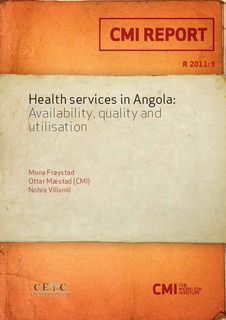Health services in Angola. Availability, quality and utilisation
Research report
Permanent lenke
http://hdl.handle.net/11250/2474713Utgivelsesdato
2011-12-16Metadata
Vis full innførselSamlinger
- Publications [1488]
Originalversjon
Bergen: Chr. Michelsen Institute (CMI Report R 2011:9) 62 p.Sammendrag
This report discusses the availability and quality of health services in two provinces of Angola (Luanda and Uíge) and reports how households perceive the level of quality and utilise the existing services. We study a sample of 40 public health facilities located in both rural and urban areas and report which services they offer as well as indicators of the quality of the services. In addition to quality indicators such as the availability of drugs, equipment and other supplies, the report explores the competence of health workers in diagnosing common illnesses. In total, 999 households from the catchment areas of the health facilities were surveyed, focusing on access to and utilisation of health services. We devote particular attention to the relationship between health seeking behaviour and socio-economic status. Data from Luanda are collected in Cazenga, Kilamba Kiaxi and Ingombota districts, while data from Uíge are from Uíge, Quitexe and Puri districts ( district is our translation of municipio ). Six hospitals, 19 health centres and 15 health posts were surveyed. Key health indicators in Angola are at a poor level. Both maternal mortality and child mortality are high, even though both have been reduced significantly since 2000. In order to improve health indicators, more information is needed about health service delivery, and about the availability, utilisation and quality of these services. This report aims to contribute to this pool of information. Policymakers could use this information to inform and improve health policies. An important and unique feature of our data set is that we have collected data both at the supply side (health facilities and health workers) and the demand side (the users) of the health system.
